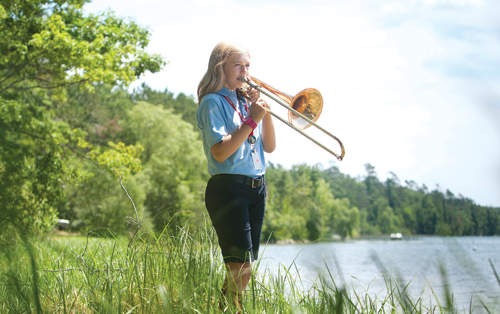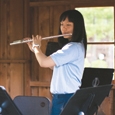
Practicing can be a source of great frustration, particularly for developing musicians. To help young players reach their highest performance potential, it is important to establish high-quality, consistent practice habits early on in their playing careers. To help develop these habits, it is critical that directors offer young musicians focused guidance throughout the practice process.
Demonstrating Effective Practice
Students sometimes have difficulty figuring out exactly how to spend their time during practice sessions. Students may assume they have practiced simply by virtue of having their instrument in-hand for fifteen minutes. To demonstrate what effective practice looks and sounds like, it can be helpful to record a video of a 20-30 minute practice session, so that students have a reference point for improving the quality of their practicing.
You can record the video and talk through the decisions you make. This will help students to understand the rationale behind certain warm-ups or for deciding when to repeat or break down a difficult passage. In the video, discuss what musical elements you might focus in on if you had more time. To make the experience even more relatable to younger musicians, consider having a local high school student help develop the video. You might also want to create several different videos to address the needs of each instrument.
By posting these videos on your class website, students will have easy access to this useful reference tool. At the beginning of the year, you might require students to answer a set of questions about the practice video, to ensure that students are making strong use of the resource. For example, you can ask students to respond to the question, “Why did the musician choose to focus on the Ab concert scale during the warm-up?” Encouraging students to consider the rationale behind various decisions made during the practice process can help them make more informed choices when crafting their own practice experience.
Developing Practice Strategies
Directors may sometimes assume the error correction techniques we use in class are automatically remembered by students when they are practicing alone. However, in conversations with some of my younger players, I discovered many students were at a loss when it came to determining exactly how they might improve a certain exercise or excerpt. Directors may consider introducing a different practice strategy each week, and deliberately emphasize that strategy in full ensemble rehearsal or small group lessons in order for your students to incorporate a similar approach at home.
For example, you may break down a sixteenth note run by having students play the first note of each group of four sixteenth notes, then adding the second and so on until you are able to play through the entire run. Or, perhaps you rehearse through a particularly tricky section under tempo to emphasize overall accuracy. While these are common strategies employed by ensemble directors, we often implement such correction techniques without explaining why that strategy might be helpful for the group or how it translates to at-home practice. Embrace these opportunities to give your students the tools to apply similar strategies during their at-home practice. To emphasize the notion of practice strategies throughout the year, consider including periodic exit slips that survey students on which practice strategies were used in rehearsal that day.
Determining Progress
One of the most difficult challenges for young musicians is recognizing when something is fixed – be it partially, temporarily, or permanently. It is important to encourage students to self-assess by asking themselves questions such as, “Did the strategies I employed improve upon or correct the problem?” or, “Can I consistently replicate an accurate performance of this piece?” Asking these questions (and considering the honest answers) can help young musicians gain a more realistic perspective on their progress. When creating an example video of an effective practice session, it is useful to point out whether something has improved and what indicators demonstrate that improvement.
Create a system through which they can label pieces or excerpts that need further attention. For example, using numbers 1, 2, and 3, students can label various excerpts according to how accurately and consistently they can perform them. Labeling a piece with a number 1 might signify that, even with some practice, the student is still struggling with a fair portion of the material. A number 2 could indicate that progress is being made, but perhaps the student is still performing the excerpt under tempo or without musicality. A number 3 might signify that the student feels confident about performing the excerpt accurately, consistently, and musically every time.
Making these indications helps students make discernments about their progress on a given piece. Additional-ly, these categories can establish priorities for the next practice session. To check in with your students regarding the accuracy of their self-ratings, you might ask them to perform one of their 3s for you during a performance assessment, enabling you to give feedback about why you agree (or disagree) with that self-rating.
Backwards Design
Many times, students learn best using a backwards design approach. For example, you might begin by having students identify two or three components of an etude or repertoire that need work. Using the 1-2-3 labeling approach mentioned previously can be a great starting point for this. Working backwards, the students might then zero in on what specifically causes the challenge in the section of music they identified, so they can ask the question, “Why is this particular section tricky for me?”
Next, students can pick one or two strategies for addressing those challenges (including those you might implement in full ensemble rehearsals), such as manipulating the articulations prior to performing those prescribed. Students can also tailor their warm-up to address the end goals they have established. For example, if a student wants to focus on adding shape to a musical phrase, the warm-up might include focused breathing exercises or extended long tones emphasizing dynamic change. Approaching practice sessions with a clear end goal in mind helps students use their time more efficiently and effectively.
Take Inventory
Many directors encourage students to submit logs of the time and dates they practice, signed by a parent or guardian. While the amount of practice time is certainly important, the content of that practice time (and the quality of the effort) is critical. One alternative is to offer the option of completing a practice journal. To complete a practice journal, students must reflect upon a particular practice session that was at least thirty consecutive minutes in length. These journals allow for deeper reflection about the practice process, and they can help directors give students more specific feedback about how they might improve their performance. Some items my students respond to include:
• What exercises, rhythms, and scales did you incorporate in your warmup today? Why did you choose those particular exercises, rhythms, and scales?
• Which etudes do you feel you performed well today and why? Which needed work and why? What strategies do you plan to use to help with areas that need improvement?
• List three specific performance goals that you would like to achieve over the next week of practice.
Each grading quarter, I require my students to submit both practice logs (minutes-based) and journals (written reflections). Which one they decide to submit is up to them, but they need to submit at least three of each throughout the grading period. Knowing this ahead of time, students are able to learn the skill of budgeting their time. For example, if students know they have a busy week ahead, and that making the minimum amount of required practice minutes may not be realistic for them that week, they can plan to spend a longer, more focused practice session that enables them to reflect via written journal. Structuring the practice assignments in this way gives students more ownership over the process and can, in turn, increase their investment in practicing.
Written journals also can provide directors with valuable information, including which practice strategies students prefer, which aspects of the repertoire students find most enjoyable, and what musical objectives students identify for themselves based upon focused self-reflection. This information can in turn help directors make more efficient use of rehearsal time, develop new considerations regarding repertoire selection, and establish more appropriate long-term goals for the ensemble.
By demystifying the art of practice, directors can help young musicians develop habits that will greatly benefit their musical progress over time. Providing examples of effective practice, highlighting various types of practice strategies, and encouraging students to reflect upon their practice are just a few ways directors can improve practice habits.
Photos courtesy of Interlochen Center for the Arts






